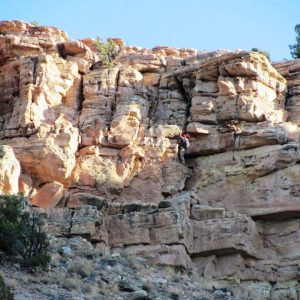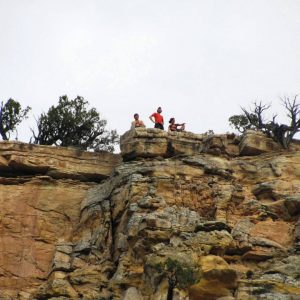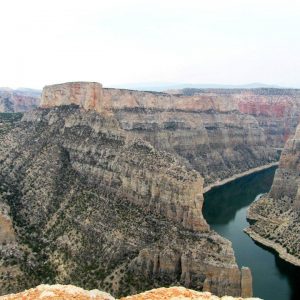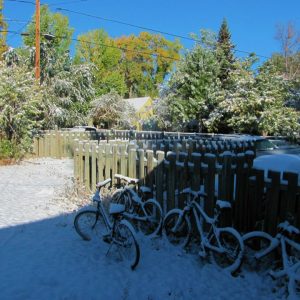It’s not easy to sum up the past 5 months here at the BLM office in Missoula, MT. I have had a wonderful experience learning all about vegetative, wildlife and stream monitoring, bird identification, rangeland health, special status plants, seed collection, forestry, GIS and so much more. But what has truly made my experience here so wonderful is the people I have had the pleasure and honor to work with. My mentor and my two field partners, John H., Lea and John F. have made my experience here unforgettable. They have all taught me so much and we have had so much fun this season. This experience would not have been the same without them. But alas, it had to end sometime, as the snow has been slowly pushing us out of the field and into the office. So on to the next adventure!
The Hunt for Rue: October
As my CLM time here in Carlsbad winds down and I finish other tasks, one project still looms large. This deadly search for African rue, a noxious weed, is the story of this month. Inevitably I call it the Hunt for Rue: October.
Along with Malta star-thistle, African rue is the most hated weed in the Carlsbad Field Office. Even its scientific name, Peganum harmala, contains within it both “harm” and “mala,” Spanish for “bad.” Around Carlsbad, rue is found on oil pads, brought in as seeds stuck in truck tires. Though rue is toxic to people and livestock, the containment strategy is based mostly on concerns over rangeland health. Should this plant escape the oil pads and invade the open range, little could stop it. Rue’s massive, branching roots can reach 20 feet in depth, and the plant makes allelopathic chemicals to suppress competitors.
“WANTED-Dead, not Alive” flyers around the office advise staffers to report this weed, which I did as soon as I saw it. The herbicide period for rue runs for just a few weeks in the spring and the fall, so spraying had to wait. In the meantime, I returned and discovered rue on other pads in the neighborhood. I recorded them until I’d checked every pad on my aerial photo, returning over the next few weeks until eventually I had checked over 600 pads spread across over 100 square miles. I created a layer in GIS showing the pads I had checked and estimates of the rue present. There always seems to be even more rue lurking just over the edge of the map.
Finally, I’ve had a chance to strike back. This week was the start of open season on African rue, when several groups of BLM staffers and contractors drove out into the oilfields toting two ton tank trailers full of blue herbicide cocktail. I was among them.
A schism exists between two camps favoring two different delivery methods. One camp favors the wand, basically a giant manual squirt gun connected by a hose to the tank, and the other favors the booms, remote herbicide blasters appended on the back of the tank trailer controlled from the cab. The wand camp charges that the boomers waste expensive herbicide by shooting a band of spray twenty feet wide to hit one plant, in the process potentially killing other plants in the area, and that boomers waste hours returning to town so they can reload. The boom camp claims the wand folks waste hours by trying to cover acres – one plant at a time. Coverage from booms is spotty due to wind, say the wand folks. Well coverage from wands is spotty due to the users’ eyesight, say the boomers. It can get heated, reflecting two different worldviews more than anything. Neither may be superior, the best method varying from pad to pad depending on weed number and density, other plants, weather, labor, funding and many other factors. In the end, everybody agrees we want African rue dead, not alive.
Leaving Nevada
 As my time as a CLM intern in the Carson City, NV BLM office comes to a close, I am reflecting on how much I have learned during this experience. After completing my second CLM internship (my first was last year in Miles City, MT), I feel like I have a more well-rounded background, which will help me in my career. I have gained a lot of knowledge from my mentor, and am very appreciative of how much training I now have which I can take with me as I search for my next field position. We attended the USDA Nevada Pesticide Applicator Certification in Salt Lake City, a grass identification course in Reno, Ecologically-based Invasive Plant Management training in Reno, and NNPS Rare Plant Meeting in Las Vegas, just to name a few. I was also able to attend Riparian and Wetland Plant identification training, from which I came away with a better understanding of those habitat types and a stronger botanical background.
As my time as a CLM intern in the Carson City, NV BLM office comes to a close, I am reflecting on how much I have learned during this experience. After completing my second CLM internship (my first was last year in Miles City, MT), I feel like I have a more well-rounded background, which will help me in my career. I have gained a lot of knowledge from my mentor, and am very appreciative of how much training I now have which I can take with me as I search for my next field position. We attended the USDA Nevada Pesticide Applicator Certification in Salt Lake City, a grass identification course in Reno, Ecologically-based Invasive Plant Management training in Reno, and NNPS Rare Plant Meeting in Las Vegas, just to name a few. I was also able to attend Riparian and Wetland Plant identification training, from which I came away with a better understanding of those habitat types and a stronger botanical background.
In addition to trainings, I have gained a wide variety of field experiences. Our team has spent time fire monitoring, rare plant monitoring, noxious weed surveying, seed collecting, and a lot more. I have really enjoyed the crew of nine interns that I have been a part of. We each bring different backgrounds to this internship and all of our skills mesh very well to form a team. I have really enjoyed getting to know each of them and it’s sad to see my time with this team come to an end. It will be interesting to see where each of us goes in 2013!
So busy!
Hello! and Greetings from Miles City, MT!
Wow, have we been busy the past few weeks. We’ve been driving out to the Special K Ranch (see Becky’s post below cleverly, and aptly, titled “Croptober”) once a week for the past three weeks to help out in any way possible and to pick up sagebrush seedling for the Miles City field office which will hopefully be planted soon.
Additionally, we’ve been busy collecting Winterfat (still working on it!), Greasewood, Green Ash (an adventure to be sure!), and as much Prairie Cordgrass seed as we can find for the Billings Office. Hopefully, we’ll be adding an aster to this list as well, we just need the weather to hold out for just a bit longer!

Green ash draw where we collected seed. Those trees are tall! We had to use a 18 ft pruner! (Which we borrowed from the Billings Office – thank you!!!!)
I know most internships are wrapping up, but I feel like mine is just getting started, soon we’ll be focusing on sagebrush seed collections and I know I’ll be just crazy busy then.
Brandee
Miles City, MT
As a matter of fact…
As a CLM intern I have learned so much about the desert that I’d like to briefly list some of the more interesting factoids –
-The Joshua Tree (Yucca brevifolia) recieved its common name from Mormon immigrants, thinking its branches resembed Joshua raising his hands to the sky. Its fruits were once consumed by the extinct Shasta ground sloth (Nothrotheriops shastense); the branches descending presumably to allow the sloths easy access to its fruits. It’s theorized that the sloths were the primary seed distributor of the Joshua Tree.
-Picking up a desert tortoise will cause it to defensively urinate, causing it to become dangerously dehydrated.
-Coyotes need no source of standing water. They can get all the water they need from their food.
-The desert is most beautiful at dawn and dusk. This is irrefutable.
-The ghost town of Rice, California was an old stopping point for steam engines to replenish their water supplies. Now it is the site of the states most famous fence; decorated with old shoes donated by passersby.
-The Salton Sea supports around 30 percent of the North American pelican population.
After learning all this, the famous line from Lawrence of Arabia, “There is nothing in the desert, and no man needs nothing” sounds so hollow! Over the last few weeks I’ve been focusing on getting as many seed collections as possible before the conclusion of my internship next month.
Aaron Sedgwick
Rancho Santa Ana Botanic Garden
“Out where the handclasp’s a little stronger, Out where the smile dwells a little longer, That’s where the West begins.” – Arthur Chapman
So thus ends my 5 months in Wyoming, working with the BLM on weed management and so so so much more. This has been an amazing experience for me and not only has my resume been improved by leaps and bounds, but I have grown tremendously as a person and I am so thrilled for unexpected opportunity. Working with a completely different ecosystem and still seeing the over arching concepts I have learned about applied has been a great learning process for me, as well as trying a slew of new things like fly fishing and home brewing. I would like to thank the BLM and the CBG for giving me this opportunity as well as all the helpful and friendly people in Worland that made my stint there fly right by. As for my reflecting on my experiences, I am going to reuse the article I wrote for a press release because I think it summed everything up nicely. Thanks for everything CBG, BLM field office in Worland, WY, interns, friends, and family.
-Nate T.
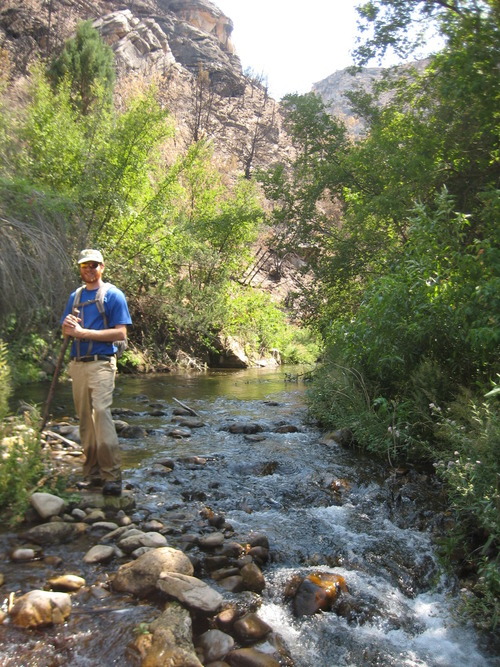
When I told my friends and family back home that I was going to Wyoming for five months, most of them responded with a puzzled look and the same question, “Why, what’s in Wyoming?” Being born and raised in New Jersey I really didn’t have a good answer. I knew I would be working on weed management, I knew Yellowstone and Grand Teton national parks are there, and I knew it is the state with the lowest population in the U.S. Other than that, I didn’t know anything about Wyoming. I didn’t know the Bighorn Mountains exist, let alone how beautiful they are. I didn’t know that parts of the Bighorn Basin are practically a desert. I didn’t know anything about sage-grouse, or that there are actually more pronghorn than people in Wyoming. I didn’t even know what the Bureau of Land Management (BLM) is or anything about public lands. I really didn’t know anything about the west, but in the short time I’ve been here, I feel like the Cowboy State has taught me well.
My internship with the BLM is through the Chicago Botanic Garden (CBG). The CBG runs a program called the Conservation and Land Management Internship Program in which it matches prospective interns with different agencies to help people get real world experience working in environmental and biological fields. I was lucky enough to be paired up with the BLM Worland Field Office (WFO), working in weed management. My mentor for the internship is C.J. Grimes, who has not only been a very helpful and informative mentor, but a friend and guide. The people at the WFO have been great and, most of all, patient with all of my questions. Learning what goes into managing public lands was eye opening; even though it isn’t always smooth, all the moving parts find a way to fit together.
The two most significant areas this internship has exposed me to are rangeland management and wildfires. I had no clue about the amount of foresight and thought that goes into rangeland management. It is so much more than just turning the cows out and then moving them after. The land is monitored and calculations are made to determine how much livestock the land can support, when the livestock needs to be moved to ensure the vegetation will be productive enough to support it next year, and to ensure there is enough forage and habitat for wildlife. It is a complex balancing act done on an enormous scale so that people can continue to make a living and habitat and wildlife can thrive at the same time.
Wildfires were also a huge change for me. Rarely are there wildfires in New Jersey and, when they do occur, they are nowhere near the size they are here. I learned that fire management is more than just trying to put a fire out. A lot of the management is done before and after a fire is actually burning. From measuring the amount of moisture in plants to thinning projects, there are many ways to figure out the risk of a potential fire and how to reduce that risk. After a fire is out, a number of monitoring and treatment projects are done to prevent the invasion of weeds. This reduces the risk and severity of future fires and ensures the land will be usable again for grazing and recreation. Fire management, or lack of it, can affect an area for decades after a fire and can be the difference between being left with thousands of acres of cheatgrass or a healthy landscape that has many uses.
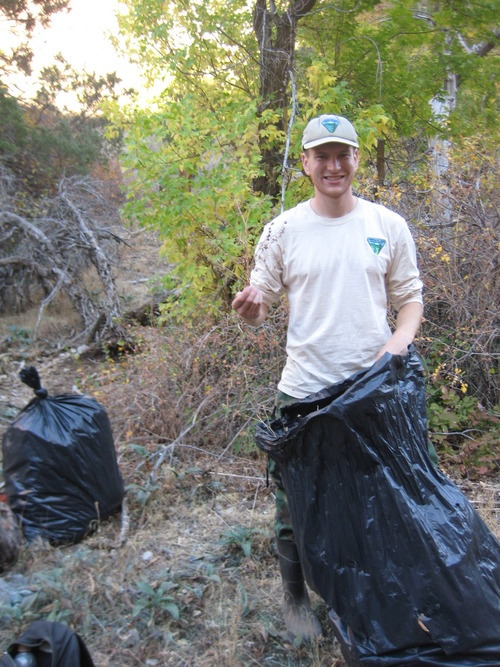
While I learned about a lot about the BLM and what it does, my internship focused on weed management. I was able to see a lot of the Bighorn Basin by surveying huge chunks of land for weeds and driving on roads that I had no idea were drivable in a Ford Explorer. I worked on a number of projects using chemical, mechanical and even some biological methods of weed control. I learned what a pain it can be to deal with invasive thistles (literally) and how difficult it is to clip houndstongue seed heads without getting covered in them. I had prior experience with invasive plant management but the sheer scale of things in Wyoming makes it a completely different ballgame.
Dealing with hundreds of acres of cheatgrass or miles of Russian olive stands make management difficult to say the least. While the size of the infestations makes things difficult, the public’s eagerness to participate makes a huge difference. It was encouraging to meet so many people who not only know what invasive plants are and why they need to be managed, but were eager to help and wanted to make a difference. Maybe it’s because more people in Wyoming make a living off the land, maybe it’s the number of hunters and anglers here, or maybe people out west just have more of an appreciation for the outdoors. Whatever the reason, the fact that there is cooperation between private land owners, nonprofits, county weed and pest districts and state and federal governments is not only amazing, but makes me very optimistic that this isn’t a losing fight against invasive species.
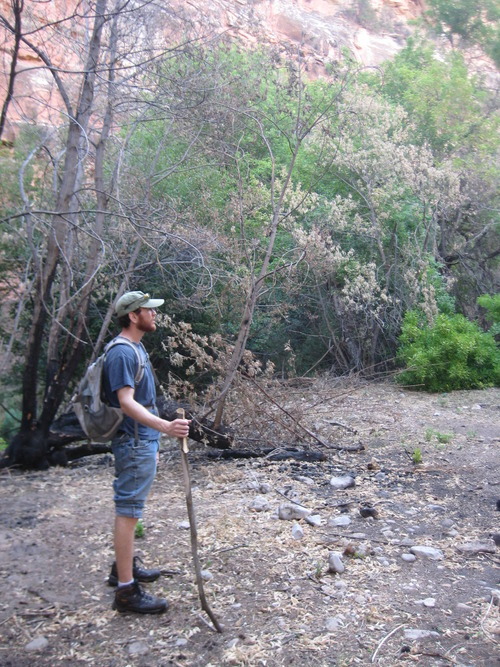
Coming out west from the east coast was a bit of a culture shock. There was definitely an adjustment from living in a densely populated area with every amenity within 15 miles, to towns of hundreds and having to travel more than 100 miles to buy things I couldn’t find in the local grocery store. After only a short while in Wyoming, I can see why people love it here. The Bighorn Basin has a rugged beauty all its own. You have to be tough to live in a place where it may only rain five inches each year and I am constantly amazed at the tenacity of the plants and animals that thrive here. The people are no different. Most of the people I have met here can roll up their sleeves and get things done and I hope a bit of that has rubbed off on me. I am excited to keep exploring the country and find my next place to work, but I know my experience in Wyoming will stick with me.
Blitzkrieg on Seed
My internship has been full of changing priorities and tasks from fire monitoring and fire intensity mapping, to evaluating range lands, to monitoring T&E plant species, but recently I have had a simple task…get as much seed as possible as fast as possible. My team and I have made so many collections so quickly that we are up to our ears in bags of seed. It has proved difficult to try to keep up with our seed and seed shipments, which has taught me that organization is key when doing seed collections.
A perk to working at the BLM Carson City District Office is that we get to do seed collections in some very different ecosystems. Last week we were at the gates of Yosemite National Park around 10, 000 ft in elevation, seed collecting in the Eastern Sierra Nevada Mountains trying to get any high elevation seed present. The last day we were in the area we had some nice snow showers, which proved bad for seed collecting, but great on the team’s spirits.
This past week we ventured out to a vast valley within out district called Dixie Valley, where we collected salt-desert species in and around a large playa. We went from collecting at 10,000+ feet to collecting at 3,000 feet in a matter of a few days. It’s really great to be able to collect different seed from so many different species and ecosystems in just a few days.
I think my team and I have made roughly 50-60 seed collections in just a weeks worth of time, which enforces the lesson that organization is key. I’m not sure if our efforts were average, good, or excellent, but I’m proud of my efforts as well as my team’s.
Throughout the field season I knew that seed collecting was going to be a major component, but it always seemed to be in the back of my mind because we were swamped with so many other tasks. Now my team and I have transitioned into a seed collecting machine, which I have been told won’t let up until probably the end of November. Our blitzkrieg on seed is bittersweet though because we are now camping in nightly temperatures of about 35 degrees and soon to be freezing. Although the nights and mornings are discomforting, the days are really nice. The rugged temperature swings are annoying at best, but I get over it when I reflect on the great work that my team and I are doing for the SOS program and our CLM internship.
Leaving MeeKer with New Eyes
As my internship concludes, I reflect not only on how much I have learned about the BLM and ecology, but also on how much I have learned about myself. I will admit that I went into this internship feeling a bit unprepared and doubting my ability to tackle every aspect of the job. I felt like a floundering fish in the midst of the newness; all the maps of where I would go and the scenes from the car windows all looked like a blur as they were thrown into my new daily routine. I remember gripping the GPS like it was the only light in the dark tunnel of the unknown. To me, the Piceance (Pee-ance) Basin, a word I dared not pronounce for the first week, appeared dry, hot, and monotonous.
It wasn’t until my third or fourth day that I got out into the field to discover that I would become one of the few to become familiar with the rare existence of the Piceance bladderpod and twinpod. I quickly embraced the role of a defender of these threatened plants and became impressed with the swift surfacing of my inner leader as I learned more and more about these plants. Right off the bat I was provided with opportunities to share my knowledge with others. With this, I had to quickly discover how I, the learner, could transition into the teacher. I had to step into the decision-making position and through this, I learned to better trust my instincts and weigh my options in a timely way. I learned that I could really rely on the foundation that I developed during my undergrad degree and that I didn’t need excessive experience to make grounded and wise decisions.

This is a site that was inspected for final reclamation. It failed for numerous reasons: a broken fence allowing for extreme grazing, and undesirable plants such as Russian thistle and Canada thistle.
My time with the plants suddenly transitioned when our field office was assigned with final reclamation inspections at well pad and pipeline sites. At first I felt as though I was given this task by default, but as I became more familiar with the inspections, I realized that I was just the right person for the job; I could even see myself continuing with reclamation in my future. Once again, when I was out in the field, I, the learner, became the teacher. I was provided with a brief overview of the inspection requirements and then sent out to lead the project. My field partner knew nothing of the inspections and I knew very little. My initial frustration ultimately dwindled into enjoyment, surprisingly. Being the leader in this role taught me everyone has some understanding to offer; my field assistant initially acted like she knew nothing at all on the task, I had to keep reminding her of what we were there to complete. I had to be persistent and creative with my questioning to keep my partner involved; eventually she dug deeper within her knowledge to offer great help. By the end of the season, we became a super-efficient team, where we each knew and completed our portions of the inspections.
I had many opportunities to see a wide variety of leadership strategies. I learned that what is most effective is for the leader to employ the skills of all team members. The worst thing I could do to myself would be to take on the entire job myself. I got to see others do this and completely stress themselves out while separating themselves from the team. I found it best to take the time to explain the entire task fully and then break up the work and delegate it to each member. While this can take longer at the beginning of a job, it makes the entire process more smooth and enjoyable. I found that the best way to tackle a daunting task is to break it up into smaller pieces done by individuals and can be done simultaneously with collaboration and corroboration at the end.
Mainly, I am walking away from my internship with a greater confidence in my leadership skills. Over this summer I have stepped into a side of myself that had been unexplored in its entirety. While I am aware that more experience will enhance and further explore this piece of myself, my CLM internship provided me with solid skills from which to draw upon. I now believe that I can accomplish what comes my way, no matter how unfamiliar.
Fall at the PMC
It’s almost been five months since I started my internship at the Lockeford PMC and change is in the air. We’ve wrapped up seed collection for the season, my fellow intern has moved on to new adventures, and it’s finally starting to cool off, with temperatures in the 70s. It should start raining soon as well. My exciting news is that my internship has been extended and I’ll be living in California for at least a few more months! There’s still plenty to do…I’ve been helping out with fall planting, attending a cover crop workshop, and learning how to do basic seed cleaning and sampling. I’m also collecting some initial data for a major soil health study. It will be an interesting next few months!
Almost Done
It’s definitely getting colder here in Buffalo. Cold, dark, and a whole lot less crowded, as our house of six seasonals/interns dwindles down to four. The field season is coming to a close and I am ready to spend the rest of my days out here in the office and in front of a computer monitor. Completing the Visual Resource Inventory for Newcastle and working on travel management for the public will be my priorities until the end. Fortunately for me though, I still have youth outreach to do as a recreation intern. That, and I’m getting a hang of ArcMap, even with the mind-blowing (-ly slow) speed at which our government computers process information.
With this cold weather, came even more opportunities for me to discover the wonders of Wyoming. We had our first snow a couple weekends ago. My roommates and I hopped out of bed, made some snow cream, and scrambled up the mountain to frolic like children. It was the best day ever. Except, the cold weather and moisture also meant that the fire ban in the Big Horn Canyon National Recreation Area was lifted. So the following weekend, we shipped off to the northern Big Horns in Montana for some much needed roasting of marshmallows. Hopefully, I’ll be around here long enough to see enough snow to hit up some slopes on the Big Horns on a snowboard.









